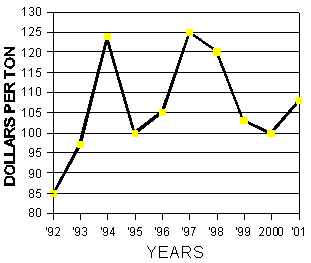Alfalfa Report
Yuma County, Arizona
April 9, 2001
Yuma County Office
2200 W. 28th Street, Ste. 102
Yuma, AZ 85364
(520) 726-3904
(520) 726-8472 FAX
Production Update:
PDF version, 14KB
Hay Preservatives (Part 2): Chemical hay preservatives include organic acids (especially propionic acid), ammonia, and urea. Propionic acid is generally thought to be the most reliable preservative, although other compounds are also effective. Horses do not relish hay treated with propionic acid, although no evidence exists to date that this compound is harmful to them. Ammonia can be used as a preservative and is often applied in an effort to boost feed value of low quality hay. Anhydrous ammonia applied at rates greater than 3% may cause toxic compounds to form and pass into milk. Urea does not have the volatility and safety problems of ammonia and is an effective preservative.
Insect Management: The granulate cutworm, Agrotis subterranea (Fabricius), is a devastating pest of bed planted alfalfa and is also an occasional pest of flood irrigated alfalfa. The cutworm larvae often go undetected until after cutting or hay removal. When fields are watered back, there may be areas with little or no regrowth due to cutworms feeding on new shoots from alfalfa crowns. Granulate cutworm is nocturnal and will move from cracks in the soil or from under duff in the evening and climb into the alfalfa canopy to feed. Some of the cutworms feed on new shoots under the duff, holding back regrowth, depleting starch reserves in the crowns and thereby weaken the plants. Weakened plants are more susceptible to disease. Permethrin, cyfluthrin and endosulfan are insecticides that control this pest. Cutworms feeding under the duff may escape insecticide treatments.
Weed Control: The weed species that predominate in the
fields are those that are left behind by our control practices. As herbicide
usage changes, the weeds change. For instance, sowthistle has become more
widespread as we have changed from 2, 4-DB to Pursuit and malva and shepardspurse
have disappeared. Nutsedge and bermudagrass have become more widespread
and annual grasses less prevalent due to the change from Eptam to Select
and Poast.
| Market Summary |
High
|
Low
|
Average
|
Off grade
|
| Past 2 Weeks (Mar. 26 to Apr. 8, 2001) |
115
|
100
|
108
|
90-100
|
| Last Year (Mar. 26 to Apr. 8, 2000) |
105
|
90
|
100
|
70-90
|
10 Year Summary (March 26, to April 9, 1992-2001):

Issued in furtherance of Cooperative Extension work, acts of May 8 and June 30, 1914, in cooperation with the U.S. Department of Agriculture, James A. Christenson, Director Cooperative Extension, College of Agriculture and Life Sciences, The University of Arizona.
The University of Arizona is an equal opportunity, affirmative action institution. The University does not discriminate on the basis of race, color, religion, sex, national origin, age, disability, veteran status, or sexual orientation in its programs and activities.
Any products, services, or organizations that are
mentioned, shown, or indirectly implied in this web document do not imply
endorsement by The University of Arizona.
Information provided by:
Barry Tickes, btickes@ag.arizona.edu Extension Agent, Yuma County
Michael Ottman, mottman@ag.arizona.edu Agronomy Specialist
College of Agriculture, The University of Arizona.
Eric Natwick, etnatwick@ucdavis.edu UCCE Imperial County - Farm Advisor
University of California, Davis, CA.
Material written April 9, 2001.
Forages: Crop Mgmt | Soil Mgmt | Irrigation | Alfalfa Reports | Insects | Diseases | Weeds | Pesticides
Home | Other Crops | Forages
For more Arizona Production Ag Information:
Home | Cotton | Veggies| Forages | Grains | Citrus | Crop x Crop | Insects | Diseases| Weeds | Pesticides | News | Weather | Research | Photos | Contacts | General Info. | Site Map
Copyright © 2001 University of Arizona,
College of Agriculture and Life Sciences
Webmaster: Al Fournier (fournier@ag.arizona.edu)